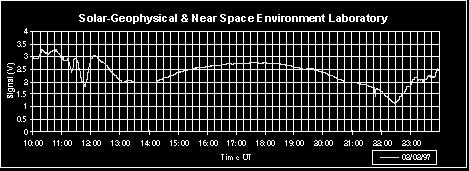The AAVSO SID Program consists of solar observers who monitor very low frequency (VLF) radio stations for sudden enhancements of their signals. Earth's ionosphere reacts to the intense X-ray and ultraviolet radiation released during a solar flare. The ionospheric disturbance enhances VLF radio propagation. By monitoring the signal strength of a distant VLF transmitter, sudden ionospheric disturbances (SIDs) are recorded and indicate a recent solar flare event.

All SID monitoring stations are homebuilt by the observers. Instructions for constructing the VLF receiver and antenna are available on this website under the SID Monitoring Overview section. Additional assistance can be obtained from the SID Program Chairman. Note that some experience with electronics is required, as well as access to certain electronic apparatus in order to build and tune a SID receiver.
Receiver design has progressed remarkably as the SID program participants have been inspired to improve signal sensitivity and noise rejection. Recent SID station receivers follow a design developed by past SID Technical Coordinators, Art Stokes and Cap Hossfield. A small indoor loop antenna captures the radio wave for amplification and rectification by the receiver. Many of the early receiving systems used simple 1 inch/hour Rustrack strip chart recorders to collect a month's worth of SID data. Recordings were then analyzed manually for the beginning, end, and duration of SID events. With computers becoming more available at reasonable cost, most SID program participants have switched to digitally recording and archiving the signal values for later processing. A simple A/D converter design for specific use with the VLF receivers must be built in order to do this. Plans are available for this as well.
SID observers must reduce their own data to produce a list of SID events they have detected for the month. The results are put into a SID report that follows a pre-defined format. Reduced data are submitted via e-mail to the SID Analyst for final analysis and correlation with other observers' results. Monthly SID event results are published in the Solar Bulletin and archived in the AAVSO SID Database. They are also sent to the National Geophysical Data Center (NGDC) for publication in the Solar-Geophysical Data Report where they are accessed by researchers worldwide.
The AAVSO Solar Committee welcomes advanced amateur astronomer participation in the SID program. The cost of the equipment is minimal and can be built fairly easily. There is also a lot of room for personal innovation in the design and construction of the observing equipment and monitoring software. The equipment and software available here on the web is by no means the only way of monitoring SIDs. The only requirement is in the final report format sent in to the SID Analyst. How you get to that point is up to you.
SID Monitoring
- SID Monitoring Overview
- SID Equipment
- SID Software
- Data Reporting
- VLF Station List
- VLF Station List (link)
- Solar Flare Classification
- FAQ
SID Data
- SID Database
- SID Observers
- Solar Bulletin (includes monthly SID report)
- NGDC Data
Additional SID Resources
- eBook - How to Build Your Own Radio Telescope (external site)
- SID Data Grabber - Preparing an AAVSO report from your Stanford/SARA superSID monitor log files
- AAVSO-SID Document Exchange Page
- Join the Solar Observing and SID Monitoring Forum
- SID-GRB resources (external site)
- VLF recording resources (external site)
For more information:
Rodney Howe, Chairman
AAVSO SID Group
ahowe@frii.com

